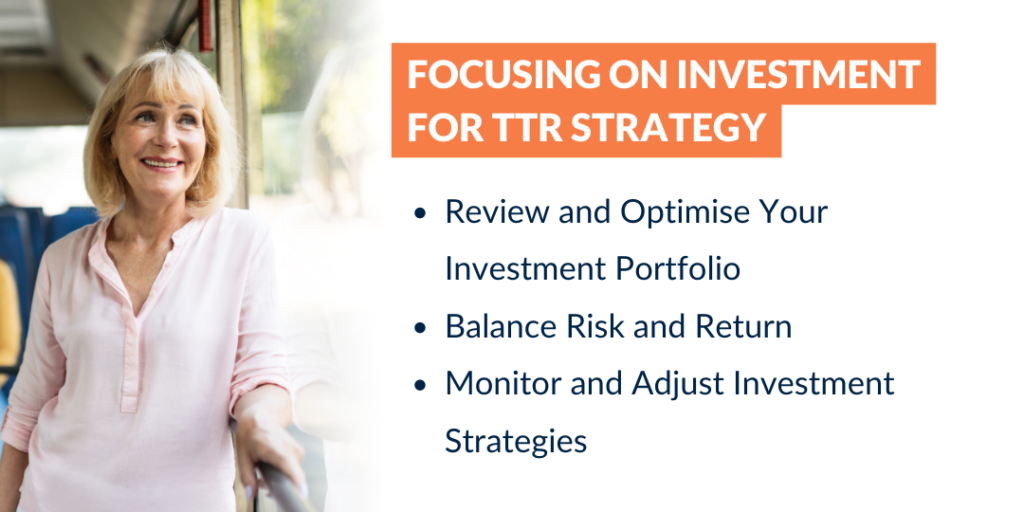
Transition to Retirement Strategy: Understanding the Benefits and Considerations
As you near retirement, a Transition to Retirement strategy, also known as a TTR strategy, can offer you an innovative way to access a portion of your superannuation even while you’re still working. This provides you with the opportunity to optimise your income and super benefits as you transition from full-time work to retirement.
In the following article, we will explore what the TTR strategy is, its benefits, and how it can help you make the most of your pre-retirement years.
The Benefits of a TTR Strategy
Retirement is a major milestone in your life, and it’s important to feel secure and confident as you approach this life stage. A TTR strategy offers numerous benefits that can enhance your financial security, as well as provide you flexibility and control over your income and lifestyle.
 Flexibility in Reducing Working Hours While Maintaining Income
Flexibility in Reducing Working Hours While Maintaining Income
A TTR strategy provides a flexible way for you to reduce your work hours while supplementing your reduced salary with income from your superannuation. For instance, working three instead of five days a week won’t significantly impact your income as you can offset it with a TTR pension.
Opportunity to Boost Retirement Savings with Additional Contributions
Continuing to work allows you to keep contributing to your super, thereby boosting your savings. You can make these contributions from your pre-tax salary (‘concessional contributions’) or your post-tax income or savings (‘non-concessional contributions’). A salary sacrifice arrangement with your employer, for example, can significantly increase your retirement savings over time.
Potential Tax Advantages and Savings Through Concessional Contributions
Concessional contributions are taxed in your super fund at a concessional rate of 15%, which is usually lower than your marginal tax rate. If your marginal tax rate is 37%, you’d pay only 15% tax on any amount of salary sacrificed into super, leading to substantial tax savings and an increased super balance.
Ability to Access Superannuation Benefits Before Retirement Age
A TTR strategy allows you to access up to 10% of your super benefits before reaching retirement age, providing an additional income stream if you decide to shift from full-time to part-time work.
Increased Financial Security and Control During the Transition Phase
A TTR strategy provides increased financial security during the transition from full-time work to retirement. It empowers you to manage your income streams and retirement savings actively, ensuring financial well-being as you transition into retirement at your own pace.
Eligibility and Requirements for TTR Strategy
The Transition to Retirement (TTR) eligibility criteria and requirements include your age, preservation rules for superannuation, pension payment requirements, and tax implications.
Age and Preservation Rules for Accessing Superannuation Benefits
Eligibility for a TTR strategy is based on your preservation age, which varies depending on your date of birth. For those born before July 1, 1960, it’s 55, and for those born after June 30, 1964, it’s 60.
Minimum and Maximum Pension Payment Requirements for TTR
The Australian Government regulates how much you can withdraw each financial year through a TTR pension. The minimum annual withdrawal is 4% and the maximum is 10% of your pension account balance to ensure your superannuation lasts throughout retirement.
Tax Implications and Considerations for TTR Withdrawals
The tax implications of a TTR strategy are based on your age and superannuation components. Before 60, the taxable component of your TTR income is taxed at your marginal rate with a 15% tax offset. After 60, the income stream is tax-free. However, a TTR pension can impact government benefits, so consider seeking advice from a financial adviser before proceeding.
Understanding these requirements can help you effectively navigate the TTR strategy, align it with your retirement goals, and optimise your retirement planning.
Calculating and Managing TTR Payments
Understanding how to calculate and manage your TTR payments effectively can have a significant impact on your overall financial well-being during this crucial phase.
Here’s how you can go about it:
1. Determine Your Optimal Pension Payment Amount
Consider your lifestyle needs, financial goals, and the annual limits set by the Australian Government. The limit ranges between 4% and 10% of your superannuation balance per financial year. A TTR calculator can help estimate the impact of different scenarios on your super balance and retirement income.
2. Manage Cash Flow and Budget During the Transition Phase
Integrate your estimated TTR pension into your overall cash flow and budget. Include salary, TTR pension payments, and other income sources, ensuring they align with your expenses. Create a detailed budget to track income and expenses, ensuring you live within your means while enjoying your desired lifestyle.
3. Review and Adjust Pension Payments as Needed
Regularly review your TTR settings, at least annually or when significant changes occur. Changes in work hours, super balance, or lifestyle needs may require adjustments. Engage with a financial adviser for valuable insights and personalised advice. They can guide you through different scenarios, consider tax implications, and help optimise your TTR strategy.
Investment Considerations for TTR Strategy
As you move towards retirement, it’s vital to reassess your investment portfolio. Here are some key areas to consider:
1. Reviewing and optimising investment portfolio during the transition phase
During this transition phase, your financial goals and risk tolerance may shift. It’s a good time to look at your accumulated assets, such as shares, property, bonds, or cash, and decide if they still align with your future plans. Optimising may involve adjusting your asset mix to better suit your retirement goals. It could mean moving from high-risk assets to more stable ones that provide steady returns.
2. Balancing risk and return based on retirement goals and timelines
In retirement planning, finding the right balance between risk and return is essential. High-return investments typically come with high risk, while low-risk options provide more modest returns. Your retirement goals and timeline can help shape this balance. For instance, if you envision an active, travel-filled early retirement, you may need higher returns, implying a higher risk. If a quiet, low-cost lifestyle is your aim, safer, steady-return investments might be better. As retirement draws closer, and the time to recover from market dips decreases, you might consider reducing your risk level.
3. Monitoring and adjusting investment strategies as retirement approaches
A TTR strategy isn’t a ‘set and forget’ plan; it needs tweaking as you get closer to retirement. Keep an eye on your investment performance, market trends, and changes in legislation that could impact your super or tax situation. If your investments aren’t meeting expectations, or if your goals or risk tolerance change, then it’s time to revisit your strategies. This could involve rebalancing your portfolio or considering new investment avenues.
Tax Considerations for TTR Strategy
Understanding how taxes affect your TTR strategy is important for a smooth retirement plan. This includes knowing how your pension payments are taxed, how taxes affect your contributions, and figuring out ways to save on tax.
TTR Pension Payments
Taxation of TTR pension payments varies based on age and the source of superannuation benefits. Under 60, the taxable portion is subject to the marginal tax rate with a 15% tax offset. Once you turn 60, the TTR pension becomes tax-free, providing significant benefits.
Managing Contributions
Effective tax management involves understanding the rules for concessional (pre-tax) and non-concessional (after-tax) contributions. Concessional contributions are taxed at 15% within the super fund, potentially lower than the marginal tax rate. Non-concessional contributions are not taxed upon entering the super fund, but contribution caps apply.
Evaluating Tax Savings and Minimising Burden
A TTR strategy offers opportunities for tax savings and increasing your superannuation savings. Salary sacrificing into super can help reduce your taxable income and overall tax liability. TTR pension earnings are tax-free, unlike the 15% tax in the accumulation phase. A financial adviser can help make your retirement plan clearer, as they can offer specific advice to help you pay less tax and save more for retirement.
Risks and Limitations of TTR Strategy
A TTR strategy helps ease you into retirement, but it’s crucial to be aware of its potential risks and limitations.
Market Volatility
Like any investment, your TTR strategy is subject to market fluctuations. A downturn can reduce your retirement savings. Consider maintaining a diversified portfolio to manage this risk, and align your investment balance with your risk tolerance and retirement goals.
Legislative Changes
Changes in superannuation legislation or tax laws could impact your TTR benefits. Stay up-to-date on these changes by improving your financial literacy as well as consulting with a financial adviser.
Risk of Depleting Savings Prematurely
One significant risk of a TTR strategy is exhausting your superannuation savings too early. Carefully calculating the drawdowns and monitoring your super balance is crucial. Working with a financial adviser can help you create a sustainable drawdown strategy.
Impacts on Social Security Entitlements
TTR pension income might affect your eligibility for government benefits like the Age Pension. Consult with a financial adviser before implementing a TTR strategy.
Professional Advice and Resources for TTR Strategy
Implementing a TTR strategy can be an intricate process, but with professional guidance and handy resources, you can successfully navigate this process.
Financial Advisor Consultation
A financial advisor can offer insights tailored to your situation, helping you understand TTR’s pros, cons, and tax implications. They can guide you in setting up your TTR strategy, managing taxes, and routinely reviewing your plan. Find a suitable advisor by checking their qualifications and expertise. Central Coast Financial Planning Group can assist you in finding a certified financial planner.
Retirement Planning Tools
Online tools like retirement planners and superannuation calculators can help gauge the TTR strategy’s impact on your retirement income and super balance. Additionally, resources provided by the Australian Securities and Investments Commission, the Australian Taxation Office, and superannuation funds offer valuable retirement planning and TTR information.
Staying Updated
Legislative changes can affect superannuation and TTR rules. Stay updated by regularly checking the Australian Taxation Office’s website, subscribing to financial news, or joining retirement planning forums.
Summary of the Transition to Retirement (TTR) Strategy
The Transition to Retirement (TTR) strategy can be a useful tool to help you navigate the complexities of planning for retirement. It provides flexibility and potential tax benefits, acting as a customisable roadmap towards achieving retirement goals. However, it’s essential to be mindful of potential hurdles such as decreased future superannuation, impacts on government benefits, and the intricacy of implementing a TTR strategy.
Enlisting the help of a financial advisor can be beneficial to navigate these challenges. With a thorough understanding of the benefits and drawbacks of a TTR strategy, you can plan effectively for a secure retirement. Remember, the decisions made today significantly influence your future retirement lifestyle. Thus, strategic planning, sound advice, and regular reviews are crucial for a secure, comfortable, and fulfilling retirement.
Plan Your Retirement with Central Coast Financial Planning Group
Retirement is a significant life milestone that allows you to rest and enjoy the fruits of your hard-earned labour. However, it’s not a one-size-fits-all plan, and since everyone has specific needs and wants, hiring an expert retirement adviser can help you plan a secure and comfortable retirement.
If you want to enjoy retirement with peace of mind knowing there is a financial strategy to take care of the future, speak to the team at Central Coast Financial Planning Group. We help our clients enjoy their dream retirement through personalised financial advice.
Call us or book online to secure your consultation today!
References:
- https://moneysmart.gov.au/retirement-income/transition-to-retirement
- https://www.australiansuper.com/retirement/transition-to-retirement
- https://www.supersa.sa.gov.au/retirement/transition-to-retirement/
- https://www.gesb.wa.gov.au/__data/assets/pdf_file/0018/2682/ttr_fact_sheet_gs.pdf
- https://www.gesb.wa.gov.au/__data/assets/pdf_file/0005/2678/tax_and_super_brochure.pdf
- https://www.ato.gov.au/individuals/super/in-detail/growing-your-super/super-contributions—too-much-can-mean-extra-tax/?page=2
- https://moneysmart.gov.au/retirement-income/retirement-income-and-tax
- https://qsuper.qld.gov.au/super/contributions/voluntary-contributions
- https://www.ato.gov.au/rates/key-superannuation-rates-and-thresholds/?page=10
DISCLAIMER: The views expressed in this publication are solely those of the author; they are not reflective or indicative of RI Advice Group’s position and are not to be attributed to RI Advice Group. They cannot be reproduced in any form without the express written consent of the author. This information (including taxation) is general in nature and does not consider your individual circumstances or needs. Do not act until you seek professional advice. Newcastle Financial Planning Group, Central Coast Financial Planning Group, Sydney Wealth Advisers, Coastal Advice Port Macquarie and Coastal Advice Ballina Byron are subsidiaries of Coastal Advice Group Pty Ltd which is a Corporate Authorised Representative of RI Advice Group Pty Ltd, ABN 23 001 774 125 AFSL 238429.







